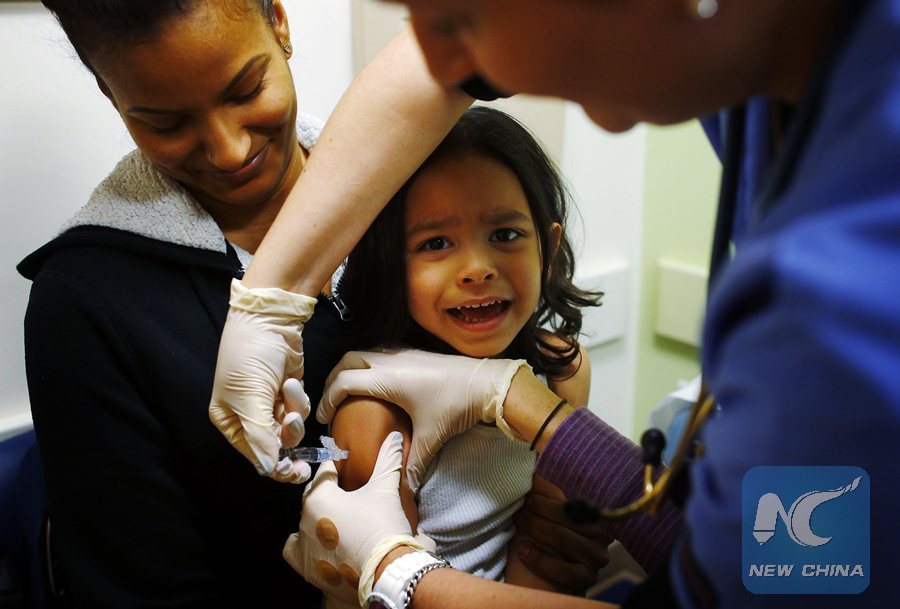Jayden Mercado, 4, sits in his mother Yariluz Ocasio's lap while he gets an influenza vaccine at Boston Children's Hospital in Boston, Massachusetts January 10, 2013. (Xinhua/REUTERS)
by Robert Stanton
HOUSTON, Jan. 27 (Xinhua) -- Houston resident Lanny Griffith had a full weekend of activities planned to celebrate the Martin Luther King Jr. Day holiday on Jan. 15.
Griffith, who is communications director for Houston City Councilman Mike Knox, attended several community meetings with residents, and visited the Chevron Houston Marathon race in the city.
When he woke up next morning, Griffith said it felt like a ton of bricks had fallen on him.
"Monday at 5 a.m. I tried to get out of bed and fell back on the bed moaning so loud my wife woke up," said Griffith, "She touched my head and knew right away it was the flu. I wanted to crawl in a hole and die."
Griffith is not suffering alone during the 2007-2018 influenza season, which officially began on Oct. 1. Nationwide, more people sought treatment for flulike illnesses in the third week of January than any other comparable period in almost a decade, according to the Centers for Disease Control and Prevention (CDC). Usually, flu activity peaks between December and March and can last as late as May.
Almost 12,000 people in the United States have been hospitalized with laboratory-confirmed influenza since the season started, the CDC reports. In the week ending Jan. 20, seven children died nationwide, bringing the total number of pediatric deaths this flu season to 37.
By the end of this season, the number of pediatric deaths could exceed the 148 deaths reported during the 2014-2015 flu season, health officials said. Most flu sufferers today are struggling with the same nasty strain of virus known as H3N2, which hit with a vengeance three years ago.
Flu activity "has now stayed at the same level at the national level for three weeks in a row with 49 states reporting widespread activity," said Dr. Dan Jernigan, director of the influenza division at CDC. "We often see different parts of the country light up at different times, but for the past three weeks the entire country has been experiencing lots of flu all at the same time.
Texas, the second largest state in the United States, is hit hard by the flu. Health officials in Galveston County in Texas reported the first flu-related death in four years - a 61-year-old woman who had pre-existing health conditions. She died in mid-January from issues related to the flu, according to the Galveston County Health District.
In Galveston County alone, more than 3,500 flu cases have been reported - a steep rise over last year when there were fewer than 500 cases.
Houston resident Danette Whitby said she would not wish the flu on anyone, and she knows first-hand just how nasty this year's bug has become.
"This flu was very disrespectful to me," said Whitby, a retired healthcare employee. "It kept me in bed for two weeks then came back with a vengeance for another week and a half. By the time the New Year rolled in, I knew I was sick. My body was aching, I had a 103 temperature and was beginning to cough and sneeze continuously."
After several days of bed rest and taking over-the-counter flu medications, Whitby said she was starting to feel better. Or so she thought.
"My body had not completely recovered from the flu so here we go again," she said. "I started to feel bad again with body and headaches. The sneezing and chills came upon me again and the next thing I knew I was back home, in bed, with the flu. After almost two weeks, I started to feel like my old self again."
One of the best tools to fight influenza is a flu shot, even though it's only about 30 percent effective against the most virulent strain. It can also help lessen the severity of the symptoms for people who come down with the flu, health officials said.


